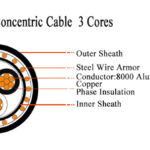Current situation of power cable and accessories
Insulating materials and shielding materials for power cables, especially materials for high-voltage and ultra-high-voltage XLPE insulated AAAC Cables, are prominent “soft ribs” or “short boards” of China’s cable industry in this field (all sheath materials have been localized). 1. Medium and low voltage power cable materials Medium and low voltage power cables are mostly insulated … Read more

